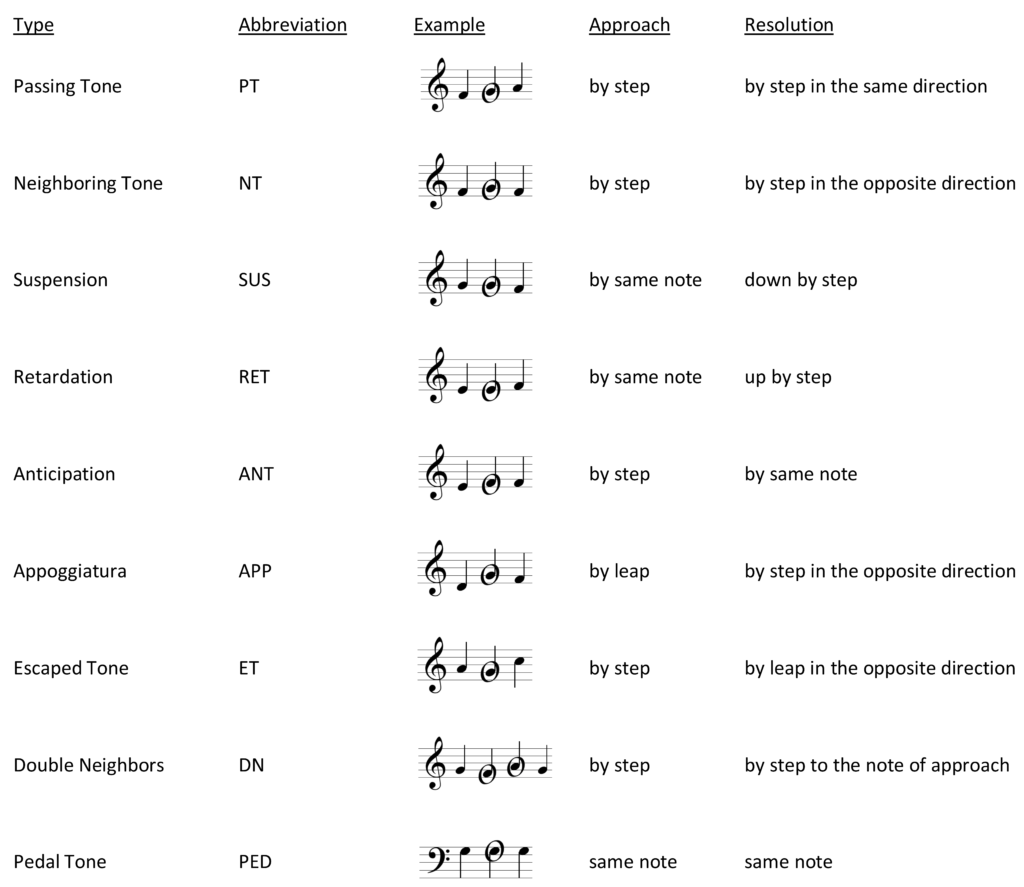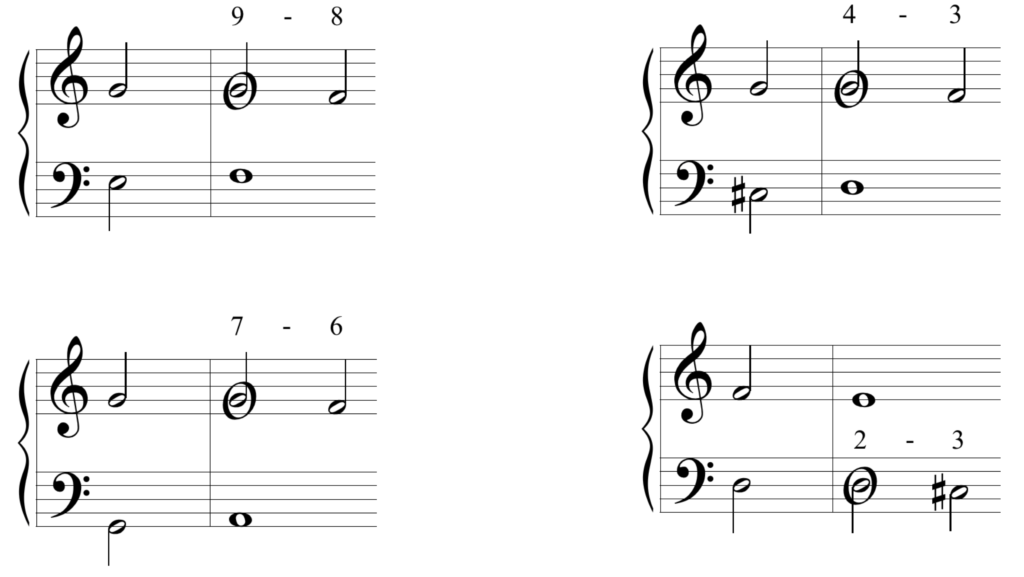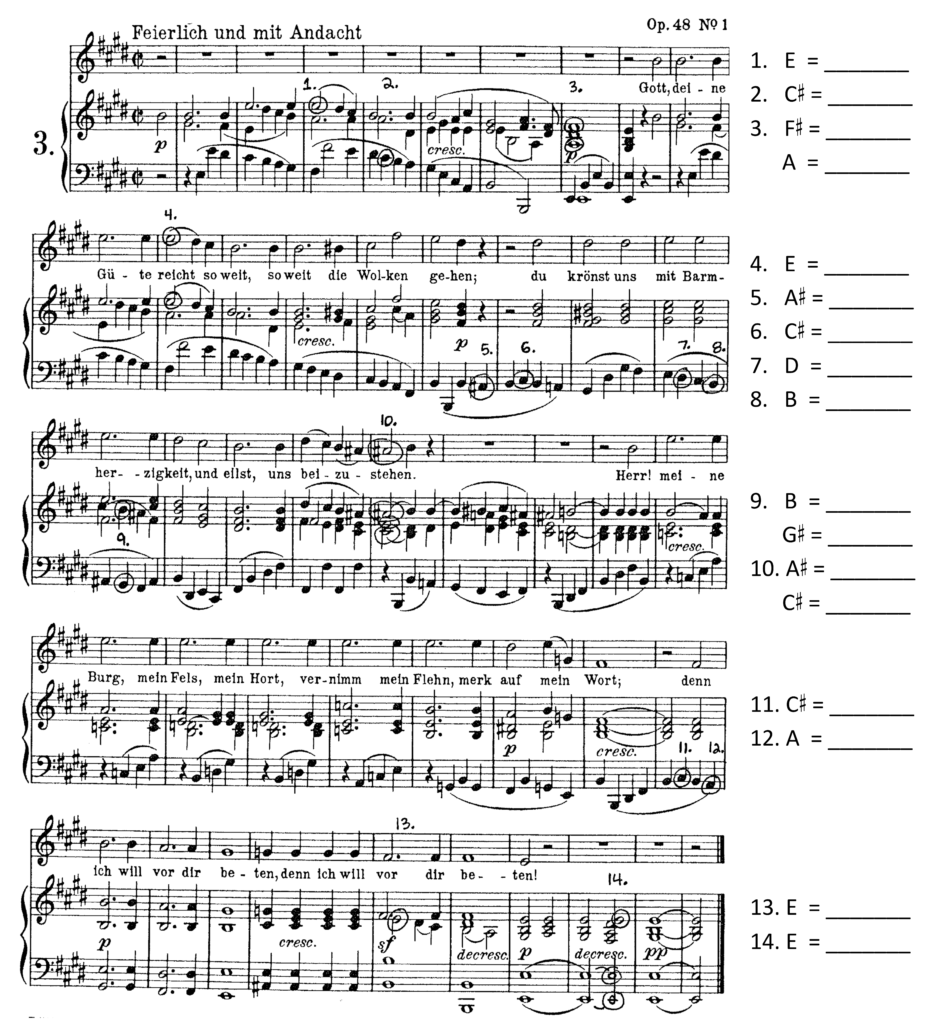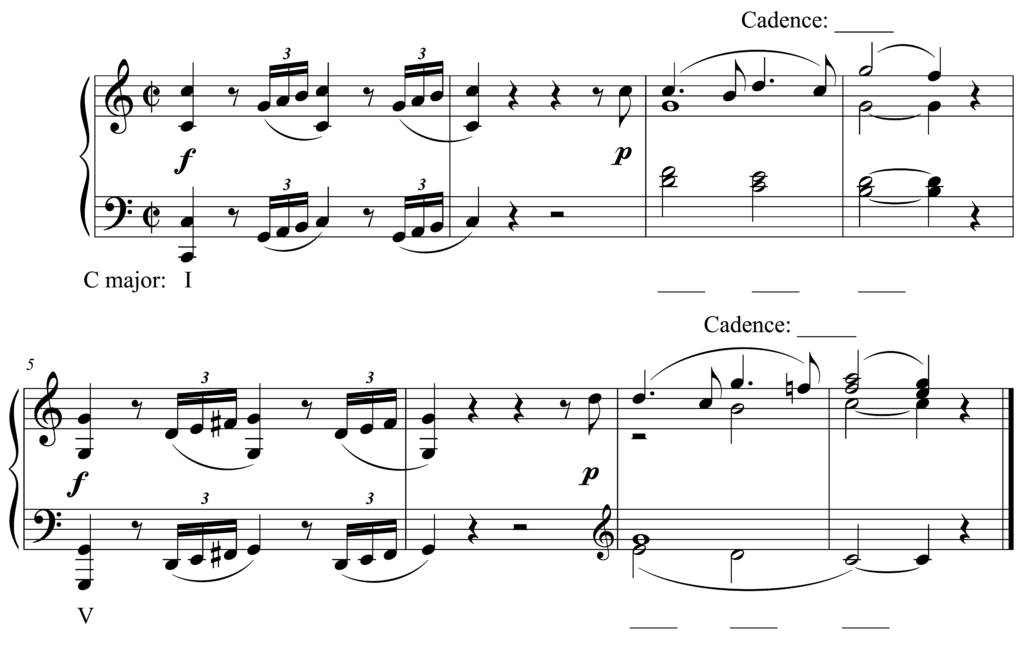Main Body
29 Non-chord tones
Learning goals for Chapter 29
In this chapter, we will learn:
- How to identify and label in analysis
- How to add to a progression to create more interest and musical drama
Non-chord tones
In our Roman numeral analysis so far, we have been disregarding notes that do not fit within a particular harmony, calling them . Non-chord tones often have an embellishing or ornamental function and may enliven any melodic line.
Non-chord tones are defined by two aspects of how they are approached and resolved: (1) the direction relative to the surrounding chord tones, and (2) the type of motion (step, leap, or same note). Figure 29‑1 shows all of the different types of non-chord tones that may occur in tonal music and explains how each is approached and resolved.
Figure 29‑1. Types of non-chord tones
Suspensions
Videos T51 and T52 below will cover each type of non-chord tone listed in Figure 29.1, but first, there are some special considerations involved in using suspensions.
typically occur on strong beats, delaying the resolution of the suspended note to the chord tone to which it resolves. There are four types of suspensions, which are labeled by the intervallic motion that occurs above the bass. Examples of each appear below in Figure 29‑2. The 9-8, 7-6, and 4-3 suspensions always occur in a voice above the bass (soprano, alto, or tenor), and the 2-3 suspension always occurs in the bass voice.
Video: T51 Intro to non-chord tones (PT, NT, SUS) (10:03)
This video introduces the concept of non-chord tones, meaning embellishing tones that we have excluded in our harmonic analysis up to this point. Specific types covered in this video include the (PT), the (NT), and the (SUS). This video further breaks down suspensions into four types based on the interval relation between the suspended note and the bass voice (the , the , the , and the , also known as the bass suspension). Finally, the video concludes with a demonstration of suspensions in Pergolesi’s Stabat Mater.
Video: T52 Non-chord tones, part 2 (RET, ANT, APP, ET, DN, PED) (8:34)
This interactive video introduces the remaining non-chord tones we haven’t studied yet: the (RET), (ANT), (APP), (ET), (DN), and the (PED). The video concludes with an exploration of Worksheet examples 29-1 and 29-2 and will require you to circle and label non-chord tones in the second example. If you want to work through this exercise on your own, see Exercise 29-1 below. Bonus example: hear the appoggiatura in action in a recording by Usher.
EXERCISE 29-1 Identifying non-chord tones
Examine the progression that appears in Worksheet example 29‑1 and compare it to the version in Worksheet example 29‑2, which has been activated with several non-chord tones. Circle and label all of the non-chord tones that appear in Worksheet example 29‑2.
EXERCISE 29-2 Analysis with non-chord tones
Listen to and study the following excerpts. Then complete the specified tasks that appear with each example.
For Worksheet example 29-3, provide labels for each of the circled and numbered non-chord tones on the blanks provided. For each suspension, please note the specific type (9-8, 7-6, 4-3, or 2-3 suspension).
Worksheet example 29‑3. Ludwig van Beethoven, op. 48, no. 1, “Bitten”
Listen to this song, performed by Peter Schreier, on Spotify.
Read an English translation of the song text on lieder.net.
Learn about German composer Ludwig van Beethoven (1770–1827) by reading this Oxford Music Online article, written by Joseph Kerman and others.
For Worksheet example 29-4, provide labels for cadences and Roman numerals on the blanks provided, then circle and label all non-chord tones. Finally, answer the question that follows the excerpt regarding the form of this passage.
Worksheet example 29‑4. W. A. Mozart, Symphony no. 41, mvt. 1, mm. 1–8
Listen to the full track, performed by the Salzburg Mozarteum Orchestra, conducted by Hans Graf, on Spotify.
Learn about Austrian composer Wolfgang Amadeus Mozart (1756–1791) by reading this Oxford Music Online article, written by Cliff Eisen and Stanley Sadie.
Which of the following terms best describes the form of this passage in Worksheet example 29-4?
- None of the above
Why?
EXERCISE 29-3 Adding non-chord tones
First, study the progression below.
Next, re-write the passage on a piece of staff paper by adding one of each of the following to alter the progression:
Use your mind’s ear or an instrument to realize the aural effect of each alteration. If you don’t like how it sounds, try a different possibility until you are pleased with the result.
Supplemental resources for Chapter 29
notes that do not belong in a given chord; for example, D would be a non-chord tone in relationship to a C major triad
a type of texture where all parts use the same rhythm, or mostly the same rhythm
type of non-chord tone that is approached by same note and resolved down by step; 9-8, 7-6, and 4-3 suspensions are labeled by the interval between the suspended note and the bass, while the bass suspension, 2-3, is formed between the bass and another upper voice
non-chord tone that is approached by step and resolved by step in the same direction
non-chord tone that is approached by step and resolved by step in the opposite direction
type of suspension in which the suspended note forms a ninth, resolving to an octave, above the bass
type of suspension in which the suspended note forms a seventh, resolving to a sixth, above the bass
type of suspension in which the suspended note forms a fourth, resolving to a third, above the bass
type of suspension in which the suspended note is in the bass voice and forms a second, resolving to a third, against another voice above it
type of non-chord tone that is prepared by same note and resolves up by step
type of non-chord tone that is prepared by step and resolves to the same note
type of non-chord tone that is prepared by leap and resolves by step in the opposite direction
type of uncommonly used non-chord tone that is prepared by step and resolves by leap in the opposite direction
type of successive non-chord tones that embellish a single note; the first note of the double neighbor is prepared by step, moves by third to the second note of the double neighbor, and then resolves by step to the initial note of approach
type of non-chord tone that is prepared and resolved by same note
unit of form that features (1) two phrases—the first ending with a weaker cadence, followed by a second ending with a stronger cadence—in which (2) both the antecedent and consequent phrase begin the same way melodically
unit of form with the following features: (1) two phrases—the first ending with a weaker cadence, followed by a second ending with a stronger cadence—and (2) antecedent and consequent phrases that begin differently
unit of form consisting of two phrases that do not have an antecedent-consequent relationship; occurs when two successive phrases end with the same cadence (for example, two phrases both ending with IACs) or when a phrase with greater conclusiveness is followed by one with greater openness (for example, a phrase ending with an IAC followed by one with a HC)







